|
And Now,
For Something Completely Different
REST IN
PEACE AND ACCLAMATION, BARD
Celebrating
the 400th Anniversary of the Death of Willie Wagstaff
William
Shakespeare died 400 years ago on April 23, almost 52 years after he was
baptized on April 26 in Stratford-on-Avon, a ritual customarily performed
within a few days of birth. Convenience and tradition have established his
birthday as April 23, 1564; for the sake of poetry, we might say, he died on
the anniversary of his birth, his birthday. Here in Harv’s Hindsight, we
commemorate both dates on the 400th anniversary of his death this
month. And we seize the opportunity afforded to defend the Bard’s reputation.
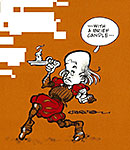
Years
ago, I used to have ferocious arguments about Shakespeare as often as I could
with Allan Gross of Insight Studios. Allan contended with some heat the
Shakespeare did not write the celebrated plays attributed to him. Scoffing
condescendingly, I disparaged his contention with an overpowering contrary
argument that convinces sensible people everywhere that I am right and he is
wrong. Allan, being only marginally sensible, remained unconvinced. And the
recent appearance of yet another tome in the assault on the Bard’s achievement
is likely to supply him with even greater reluctance to admit that he’s wrong
and I’m right.
The
Truth Will Out: Unmasking The Real Shakespeare by William Rubinstein and
Brenda James offers yet another candidate for the dubious distinction of having
secretly authored Shakespeare’s plays. I haven’t read it. But I have read a
good deal of the literature debunking the so-called Shakespeare’s claimants,
and I am almost certain that this theory, like all of the others that have gone
before, is balderdash.
The
new candidate for the playwright of Shakesspeare’s plays is Sir Henry Neville,
who was discovered by James while she was pawing through the plays on another
errand, using a 16th century code-breaking technique. She did not
expect to discover the true identity of the person who wrote the plays, but,
she believes, she did. Once Neville was revealed, it was discovered that the
locales of the plays, arranged in their supposed order of composition, reflect
the places Neville was traveling at the times the plays were written. Moreover,
Neville’s ancestors, the Plantagenets, are always favorably portrayed in the
plays. A conclusive happenstance, obviously. And there’s more of the same. But,
as I said, I haven’t actually read the book, so I shouldn’t be dismissive of
it. Still, considering the failure of its predecessors in this exercise of
debunking Shakespearean authorship, it’s difficult not to be nonchalant.
During
a trip to England in the summer of 2005, I and my wife stayed in
Stratford-on-Avon for five days, and I tramped around the Shakespeare sites,
looking for more evidence to shore up my side of the argument. Shakespeare
being the local industry there, you can find plenty of evidence of the high
regard the Bard's contemporaries held him in. Among the evidences, an
impressive bust of the man, purporting likeness, over his grave in a local
church, the Holy Trinity. And the bust holds a pen and a piece of
parchment—symbolizing his profession ass a writer. His fellow citizens would
scarcely have erected this monument to a fraud: clearly, they believed he'd
written his plays. 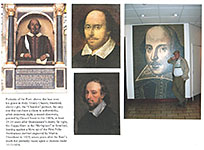
That,
of course, proves nothing: if Shakespeare's alleged authorship of some three
dozen plays, many masterpieces of English literature, were part of an elaborate
conspiracy at the heart of which was the secret of the real author's identity,
the monument on the wall of that church proves only that his fellow citizens
weren't in on the secret. They, like everyone else, were fooled.
But
we don’t need to visit Stratford for validation of Shakespeare as author of the
plays attributed to him.
Doubts
about Shakespeare's authorship have their roots in an ignorance of Elizabethan
England that prevailed in the middle of the nineteenth century. Several
otherwise respectable personages became convinced that Shakespeare, a poor
glover's son in a provincial town, could not have possessed the education or
experience to have written the works of genius attributed to him. Shakespeare's
plays, these people maintained, were actually written by a contemporary of his,
a noted politician, historian and essayist named Francis Bacon, who, as a
member of the upper classes, did have the education and experience that the
plays attest to.
None
of these “Baconians,” as they became known, was a literary scholar. Nor, as
Brian Vickers noted in The Times Literary Supplement (August 17, 2005),
did any feel “the need to acquire any knowledge of English literature or of the
English language in the sixteenth century, and none bothered to read Bacon. ...
All they needed was the preconceived notion that Shakespeare could not have
written the plays while Bacon could.”
Mere
probability was not, however, enough for the Baconians. They also claimed to
have discovered “messages” hidden in the texts of the plays that disavowed
Shakespeare’s authorship and authenticated Bacon’s. The messages could be found
by deploying convoluted codes that revealed such statements as: “Shakst spur
never writ a word of them”; and “FRA BA WRT EAR AY,” which, the inventor of the
code claimed, meant, “Francis Bacon Wrote Shakespeare’s Plays.”
Unfortunately,
the codes were inconsistent: they changed from page to page. One skeptic used
one of them to find this message: “Master William Shakespeare writ the plays.”
Besides,
if Shakespeare didn’t write his plays, what was he doing? The answer: he was
translating the Bible into the King James Version. And we know this because of
his signature that he inserted into the text. If you go to the 46th Psalm and count 46 words from the beginning, you’ll get the word “shake”; and
if you count 46 words back from the ending, you’ll get “spear.”
Obviously,
applying Baconian logic, Shakespeare translated the King James Version of the
Bible. Why the 46th Psalm? That was how old Shakespeare was when he
finished.
Such
scholarly foolishness aside, the Baconian authorship theory gave birth, in due
course, to other theories, which offered other people as the probable
authors—William Stanley, the Earl of Derby; Edward de Vere, Earl of Oxford;
even Christopher Marlowe, another of the playwrights in the milieu of London
theater at the time; and a half-dozen others. You can find them all described
and debunked in The Shakespeare Claimants (1962) by H.N. Gibson.
Although the arguments in favor of other authors are unrelentingly ingenious,
they are all flummery.
IN THE DECADES
SINCE the mid-1800s, we have learned a great deal more than we knew then about
Shakespeare's early life, and the more we have learned, the less unlikely it is
that a "poor glover's son" could have written the plays.
Shakespeare's
father, John, was a glover, true; but he was also a respected member of the
middle class, even the upper middle class. Elected an alderman the year after
William was born, he was eventually mayor of Stratford. He had both social
position and wealth enough to send his son to the local grammar school, where
young Will was inculcated with the usual curriculum, which included Latin and,
maybe, Greek as well as a certain amount of history and the like. In short,
little Willie Wagstaff was not "poor"; and he was not an uneducated
country bumpkin who wandered onto the London stage just in time to be adopted
by some unknown genius who wanted him to pose as the author of his plays. So
there is no longer any justification, as there was when we knew less about life
in Elizabethan England, for disbelieving that Shakespeare wrote the plays
attributed to him.
There
is, however, a mystery in Shakespeare’s life. Making someone else the author of
his plays does not solve the mystery, but the mystery has provoked other myths
about the playwright. Shakespeare married Anne Hathaway, a woman eight years
older than he, in November 1582. Various of Shakespeare’s biographers have
assumed that the older woman inaugurated him into the pleasures of the flesh
when he was 18. She became pregnant, hence the hastily arranged wedding: the
marriage bans were read only once instead of the usual three times. And six
months later, Shakespeare’s daughter Susanna was born. Twins, Hamnet and
Judith, were born to the Shakespeares in February 1585. And after that, we have
no documentation about Shakespeare until his name crops up in the 1592 jottings
of a ill-tempered writer in London, whose jape about “an upstart crow
beautified with our feathers” who is “in his own conceit the only Shake-scene
in a country” recognizes Shakespeare’s emergence as a playwright in the
nation’s capital.
From
1585 until 1592, in other words, we lost track of Shakespeare. During these
“lost years,” we know nothing of what Shakespeare might have been doing. We
have only our assumption that he somehow made his way from Stratford to London,
from glover’s son to playwright. But we have no knowledge of the steps he took.
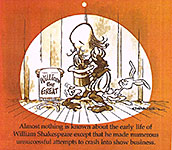
An
ingenious pair of writers, Graham Phillips and Martin Keatman, have undertaken
the task of filling in this blank and, at the same time, explaining various
inconsistencies in Shakespeare’s life in a book entitled The Shakespeare
Conspiracy. This biography claims that the Bard led a double life. Why, for
example, is Shakespeare known in his hometown of Stratford only as a grain
merchant, not as a famous London playwright? The answer: Shakespeare didn’t
want the Stratfordians to know. The reason: when he was not writing plays or
hanging out with his fellow actors in some London tavern, he was a spy, working
in the Elizabethan Secret Service operated by Francis Walsingham.
During
the “lost years,” Shakespeare was sharpening his espionage skills while traveling
the Continent on an assortment of missions (and picking up incidental knowledge
that he would later use in writing his plays).
Phillips
and Keatman make a convincing case, but it seems built upon a shaky foundation.
The monument to Shakespeare in the Holy Trinity church was erected sometime
between his death in 1616 and the publication of 36 of his plays in the First
Folio in 1623. And it is a monument to a writer, not a grain merchant. The
Stratfordians knew Shakespeare was a writer. Phillips and Keatman’s happy
narrative is therefore a pleasant read but a fiction for all that.
Not
quite. The monument with the bust that we see today was made in 1748 when the
original required restoration, P&K say. The original memorial, the one put
in the church just after Shakespeare’s death by Stratfordians who knew him as
the well-to-do owner of the second grandest house in town (New Place), looks
quite different. The personage depicted was thinner in the face than the
present robust bust. His moustache was longer and drooped. And this original
Shakespeare was not holding a pen and a manuscript: his hands rested upon a
sack—a sack of grain, no doubt.
Obviously,
to the Stratfordians who knew him, Shakespeare was a grain merchant, not a
playwright. And P&K may well be right about the Bard’s double life.
The
evidence of the original appearance of Shakespeare bust can be found, P&K
announce, in two drawings made before the 1748 restoration: one can be found in
Nicholas Rowe’s 1709 biography of Shakespeare; the other (which we reproduce
hereabouts), in Sir William Dugdale’s 1656 Antiquities of Warwickshire. 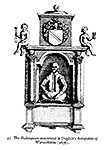
How
come we’ve never seen these drawings before? I’ve seen several paintings that
purport to be of Shakespeare—and, of course, the familiar Martin Droeshout
engraving that appears on the title page of the First Folio—but in all the
ensuing discussions of the accuracy of the likenesses, no one mentions the two
drawings that P&K refer to, reproducing one of them in their book.
And
so suspicion and contention and frustration prevail apace. And, no doubt, ever
will.
But
these few sentences about Shakespeare’s espionage career provide me with an
excuse to post the accompanying two pictures of Shakespeare—on the left, one of
the most convivial renderings I’ve ever beheld (an interpretation, however, not
purporting at all to be a likeness).
And, on the right,
another happy interpretation, this one by the celebrated caricaturist David
Levine.
AT THE RISK OF
PROLONGING THIS DETOUR, Shakespeare’s appearance has been as hotly debated as
the authorship of his plays. For the longest time, only two portraits were
accepted as authentic likenesses of the Bard. Both of them appear in the
illustration we posted a several paragraphs ago—the bust in the Holy Trinity
church in Stratford and the frontispiece of the First Folio, the Droeshout
engraving (against an enlargement of which I am leaning in the photograph).
Posthumous renditions, both. P&K, as we’ve seen, have successfully
destroyed—or, at least, seriously undermined—the authenticity of the Holy
Trinity bust: what we see today is a reconstruction so at odds with the appearance
of the drawing of the original bust as to qualify as no more than a work of
pure imagination.
The
Droeshout engraving, then, is the only picture of Shakespeare that everyone can
agree is a fair likeness. Playwright Ben Jonson, who knew Shakespeare, strenuously
implied in his dedicatory poem in the First Folio that the engraving looked
like his fellow playwright. And other contemporaries of Jonson and Shakespeare
testified variously in agreement.
This,
however, is but the beginning of a contorted tale. Droeshout did not have the
living Shakespeare as his model: he was only 15 years old when Shakespeare
died. Droeshout was using someone else’s drawing or painting, which he copied,
as best he could, in making his engraving. Droeshout was only 21 at the time
and therefore not very experienced as an engraver. Most experts who ponder his
engraving assume that it is, at best, only a modest approximation of the
picture he used as a reference.
Where,
everyone wonders, is that picture? If it exists at all, it may be the only
portrait of Shakespeare made of the play wright when he was living. A
search for this mystery portrait has been transpiring for centuries.
Since
the National Portrait Gallery was established in London in 1856, more than 60
portraits of 16th and 17th century gentlemen have been
offered to the Gallery purporting to be portraits of Shakespeare. Most have
been proven to be less than authentic for one reason or another. The Soest
painting, for example—which appears in our early exhibit with the Holy Trinity
bust and the Droeshout engraving—was, a dozen years ago when I first assembled
the exhibit, seriously considered as a possible likeness of Shakespeare. Since
then, it has been established that the painter, Gerard Soest, used as his model
a man who was said to look like Shakespeare, not Shakespeare himself. Moreover,
the painting was done in the late 1660s, so it is scarcely a portrait of the
living Shakespeare.
The
Chandos portrait, the last of the quartet in our exhibit, was painted in about
1610, so it has the best chance of being a portrait from life. It also has the
virtue of looking a lot like the Droeshout engraving; it could well be the
model from which the young engraver worked. It acquired its present name
because it was once in the possession of the Duke of Chandos; but how he came
by it, no one knows.
Then
in 2009, another claimant came forward. This is the Cobbe portrait, so-called
because it was in the possession of the Cobbe family.  This portrait, like the
Chandos picture, looks a good deal like the Droeshout engraving—except that the
Cobbe Shakespeare’s hairline has not receded as far as the Droeshout’s (perhaps
the painter was flattering his subject). And the Cobbe Shakespeare is somewhat
thinner in the cheeks—reminding us, maybe, of the Dugdale drawing of the bust
in the Holy Trinity church. This portrait, like the
Chandos picture, looks a good deal like the Droeshout engraving—except that the
Cobbe Shakespeare’s hairline has not receded as far as the Droeshout’s (perhaps
the painter was flattering his subject). And the Cobbe Shakespeare is somewhat
thinner in the cheeks—reminding us, maybe, of the Dugdale drawing of the bust
in the Holy Trinity church.
And
the provenance of the Cobbe painting is significant: it has been with the Cobbe
family since the early 18th century, having descended to the family
through a cousin’s marriage to the great granddaughter of Shakespeare’s only
literary patron, Henry Wriothesley, the 3rd Earl of Southampton.
Here, then, is the connection to the playwright that all the other pictures
lack. Wriothesley may have had the portrait done as a gift to the poet he’d
taken under his wing.
Stanley
Wells, chairman of the Shakespeare Birthplace Trust, believes that the Cobbe
Shakespeare is the only portrait painted from life—in about 1610, when the
playwright was 46 years old. However, an expert specializing in 17th century art disagrees and says the portrait is of another individual
altogether. It is ever thus: every good idea is whittled down in size by some
jealous malcontent.
An
interested and dedicated amateur Shakespeare scholar, Tom Christensen, has
created another new portrait of Shakespeare by computer morphing together the
Chandos and Cobbe portraits (at rightreading.com) with 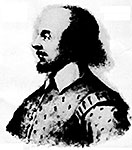 fascinating results. It
looks like all three—Chandos, Cobbe, and Droeshout. fascinating results. It
looks like all three—Chandos, Cobbe, and Droeshout.
And
then along came S. Schoenbaum, Distinguished Professor of Renaissance Studies
at the University of Maryland, who wrote William Shakespeare: A Compact
Documentary Life and used as the cover illustration for the 1987 paperback
edition the portrait posted nearby, “from a recently recovered miniature by
George Vertue” (who was born in 1684, too late to know Shakespeare in the
flesh; but it’s a nice, friendly picture of a bearded, balding
Shakespearean-like man).
And
so the search goes on. But it will go on without us for now.
FOR NOW, WE
RETURN to where we were when I so rudely interrupted us—namely, to the disputed
authorship of Shakespeare’s plays. While the excuse for finding someone else to
have written them—namely, that Shakespeare was an ignorant country lout without
the education or experience to pen masterpieces—has evaporated, the followers
of the Baconians continue, as we’ve seen in Rubinstein and James, to put
forward other claimants.
Those
who offer some other author for Shakespeare's plays must successfully perform a
succession of intellectual gymnastics. First, assuming that the general
schooling customs of the time are still viewed as not adequate for producing
Shakespeare's evident learning and knowledge, the alternate author must be
someone who can write. To prove the claimant can write, evidence of his ability
must be produced. And in producing this evidence, these theorists run into the
first contradictory predicament, to which I'll return in a trice.
The
second argument the theorists must win is the one that supplies a reason for
the alternate author's keeping his identity secret. The usual reason is that
"writing"—particularly in association with scruffy and disreputable
London actors—was not, then, a respectable profession (anymore than writing
comic books was respectable before the advent of graphic novels, which gave the
medium literary and therefore social status). If the real author were a
nobleman or a respected member of the upper class, he would not want to sully
his name and reputation by becoming known as a playwright. But (and here’s
where we come to the contradictory predicament) if such a claimant had produced
enough writing to prove that he could have written the plays, he would be known
as a writer, his reputation would, perforce, be sullied already.
Well,
maybe playwrighting was deemed a less respectable sort of writing than any
other; maybe it was just writing plays that was so shameful that the would-be
author wanted to keep his participation in London's theatrical life a deep,
dark secret. Let's grant that proposition and move to the next hurdle: why did
the secret author of the plays pick Shakespeare as his "stand-in"?
What was there about this country clodhopper that made him the obvious choice?
Assuming
that the ingenuity of the theorists can contrive an explanation for this, we
next need a convincing explanation for how the secret was kept. Clearly, this
secret was the most well-kept secret in Western Civilization: no one,
apparently, knew that Will Shakespeare, a minor-league actor who wrote plays
for his company, wasn't really writing the plays. It defies our experience of
human nature to suppose that the secret authorship would be known by several
persons, none of whom ever divulged it.
Obviously,
since no one spilled the beans, the secret was known only by Shakespeare and
the claimant himself.
How
was the secret maintained? If Shakespeare's colleagues in the acting company
didn't know about it, how did Shakespeare explain his seeming inability to make
script changes on-the-spot? If the company’s leading actor Richard Burbage
demanded an adjustment in his speech, he would, it can be imagined, expect the
playwright to make the changes right there, during rehearsal. But if
Shakespeare hadn't written the play to begin with, how could he make such
changes? Particularly with his fellow actors looking over his shoulder as he
wrote. So what would Shakespeare say to avoid the necessity of making the
changes immediately? "Okay, okay—you win. I'll make the changes tonight,
and you'll have a new speech tomorrow"?
But
maybe his colleagues did know the secret. If they did, however, why would they
keep it a secret? What compelling reason would persuade them all, to a man, to
keep the secret to the grave?
But,
enough. If the absurdity of the alternate authorship theories isn't apparent in
the difficulties surrounding their invention and maintenance, there is yet
another reason for denying their efficacy. All of the claimants are put forward
in the conviction that Shakespeare could not have written the plays—for one
reason or another. Our knowledge of his early life—of the years between his
schooling, which ended, probably, when he was about fourteen, and his arrival
in London in the early 1590s as a young man well into his twenties—while
greater than it was in the mid-1800s, is still pretty skimpy, and the vacuum
still fosters doubts about the supposed Bard's training and experience. How
could a man whose life is so unknown have the intellectual wherewithal to
produce such impressive literature?
The
answer—which, I submit, lays waste to any argument against Shakespeare's
authorship—is simplicity itself, an exercise in logic, not scholarship. The
plays are universally acknowledged as works of genius. And we cannot explain
genius. A genius doesn't need a college education in order to flourish. A
genius would find ways to educate himself about whatever he decided he needed
to know. The arguments against Shakespeare's authorship crumble away forthwith.
If the plays are the works of genius, then Shakespeare was a genius, and we
require no further explanation for his ability and achievement.
ONE OF THE
REASONS Shakespeare as author of his plays has been vulnerable to attack is
that until quite recently, his adherents were as passionate as the attackers:
neither side would admit of exceptions to their generalities or evidence that
contradicted them. Bardolators were often as misguided and misinformed as Baconians.
But that has changed.
Recent
scholarship, for instance, has admitted a couple more plays to the so-called
Shakespeare canon—"Edward III" and "Sir Thomas More." Both
are collaborations in which Shakespeare had a hand but did not produce,
single-handedly, the entire script. Similarly, “Pericles, Prince of Tyre” and
“The Two Noble Kinsmen” are collaborations. The latter is attributed, when
published in quarto in 1634, on its title page to both Shakespeare and John
Fletcher, who succeeded Shakespeare as house playwright for the King’s Men
theater company. None of these four plays, however, appear in the First Folio,
which, as we’ll soon see, has, for generations, defined the canonical
Shakespeare at 36 plays.
The
First Folio includes “Cymbeline,” “Henry VI, Part 1,” “Titus Andronicus,”
"Timon of Athens," "Measure for Measure,"
"Macbeth," and "Henry VIII"—all of which, saith today’s
scholars, involve some collaboration. The extent varies: some scholars say Shakespeare
wrote about 20% of “Henry VI, Part 1"; but “Measure for Measure” involves
only “light revision” by Thomas Middleton at some point after its original
composition. Middleton is also thought to have revised “Macbeth” in 1615 to
incorporate musical sequences.
Shakespeare
further complicated the authenticity puzzle by re-writing his own plays,
sometimes so extensively that two noticeably different versions of the same
play exist. According to St. Wikipedia, “to provide a modern text in such
cases, editors must face the choice between the original first version and the
later, revised, usually more theatrical version.” Sometimes, they have
conflated the texts to produce “a superior Ur-text,” but critics recently have
argued that conflated texts run contrary to Shakespeare’s obvious intention—to
improve upon his initial composition.
With
“King Lear,” which exists in two independent versions, “each with its own
textual integrity” and structure (one in quarto, one in the First Folio), the Oxford
Complete Works of Shakespeare, published in 1986 (and again in 2005),
provides both versions of the play. The same problem occurs with at least four
other plays—“Henry IV, Part 1,” “Hamlet,” “Troilus and Cressida,” and
“Othello.”
Stanley
Wells, one of the general editors of the Oxford Shakespeare, said a few
years ago: "The world of Shakespeare studies has largely come around to
the view that we espoused of Shakespeare as a collaborator ... [accepting]
Shakespeare as a writer working among a community of writers, and not, as he
has often been perceived in the past, the mysterious, lone-God-figure, passing
his works down ... as from an ivory tower."
The
latest play to be added to the canon, "Sir Thomas More," was never
printed until recently—and it exists in manuscript. The manuscript itself
reveals much about how plays were written: the original hand-written text,
attributed to Anthony Munday, shows the hands of at least four others, which
scholars have identified as Henry Chettle, Thomas Dekker, Thomas Heywood, and
Shakespeare.
I
have no quarrel with Shakespeare as a collaborator in a "community of
writers" and actors, all engaged in the production of material for
staging. But in allowing Shakespeare his collaborators on a few plays, we need
not attribute all of his plays to another, or others. His collaborators were
not the sole authors of the aforementioned plays any more than Shakespeare was.
At the same time, modern scholarship, while admitting collaborators on a few of
the usual Shakespearean canon, does not admit them on all of Shakespeare's
plays.
Shakespeare's
contribution to "Sir Thomas More," by the way, consists of just two
relatively short passages, not whole scenes or subplots. The bulk of the play
is still Munday's. Presumably, the same can be said for Shakespeare's
authorship of others of his plays traditionally assigned to him but now seen as
collaborative efforts—"Measure for Measure," "Macbeth,"
etc. Shakespeare probably wrote most of these plays while various passages
within were contributed by others.
Even
in the "community of writers," Shakespeare is still presumed to have
written plays virtually single-handed; or, as in the case of “Measure for
Measure” and the other collaborations, he took a commanding lead in devising
those his name has historically been associated with. And this takes nothing
away from his genius, which is the best explanation for the superiority of
these works in the lists of dramas in the English language.
For
our entire experience of Shakespeare’s genius, we are indebted to the
publishers of the First Folio, without which, remarkable as it seems, we would
probably have never heard of Shakespeare or been able to appreciate his
literary achievement.
None
of the manuscripts of Shakespeare’s plays have survived (except for the
aforementioned “Sir Thomas Moore”) so our knowledge of his work depends
entirely on the printed plays. Only 14 of his plays were printed during his
lifetime, the quarto editions, all garbled versions of the actual texts—stolen
from prompt book versions (that were inherently corrupted for use doing
performances) or reconstructed from memory and notes taken by people who
attended the plays in performance for the purpose of “transcribing” the
proceedings to create published versions of the plays, the quartos. None of
these productions, in other words, were supervised by Shakespeare; all are, in
today’s terminology, unauthorized.
The
First Folio, published in 1623, seven years after Shakespeare died, printed 36
of his plays, the entire canon—to which scholars have subsequently added
another four that they’ve determined were partially written by Shakespeare. Of
the 40 plays now accepted as either wholly or partly written by Shakespeare, we
know of 18 only because the First Folio was published.
And
the First Folio is undeniably authoritative: it was assembled by John Heminge
and Henry Condell, names that would doubtless have been lost to history without
the First Folio. Heminge and Condell had been actors in Shakespeare’s acting
company at the Globe Theatre; they had known him personally and his plays
intimately. And by 1623, they were the last living members of that company. The
contents of the First Folio they assembled from whatever manuscripts remained
in the company’s possession plus the 14 quartos—all augmented by their fading
memories of lines they’d performed on stage alongside Shakespeare.
Heminge
and Condell said the First Folio replaced earlier published plays, the quartos,
which they called “stol’n and surreptitious copies, maimed and deformed by
frauds and stealths of injurious imposters.”
One
of the oft-overlooked sights in London is the so-called “publishers’ monument.”
Located in the old city far away from Trafalgar Square, the Houses of
Parliament, the Tower of London, Westminster Abbey and the rest of the usual
tourist destinations, the 1896 monument sits on the flagstone paving of a tiny
park, maybe 20x20-feet, surrounded by shrubs and benches in what was once a
corner of the churchyard of St. Mary Aldermanbury (which was all but destroyed
during the bombings of London during World War II; the remaining walls were
transported in 1966 to Fulton, Missouri, where the church was rebuilt as a
memorial to Winston Churchill, who had given there his famous “iron curtain”
speech about post World War II Russia). 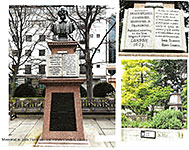 Unless you went looking expressly for it, you
would not ever know it was there—a memorial to the men who “created”
Shakespeare: without them, the English language’s greatest playwright would
scarcely exist. Unless you went looking expressly for it, you
would not ever know it was there—a memorial to the men who “created”
Shakespeare: without them, the English language’s greatest playwright would
scarcely exist.
Paul
Collins, an assistant professor of English at Portland State University and
editor of the Collins Library imprint of McSweeney’s Books who appears
regularly on NPR’s “Weekend Edition” as the program’s resident literary
detective, has written a engaging, readable book about the First Folio, The
Book of William: How Shakespeare’s First Folio Conquered the World. In the
book, he conducts an anecdotal expedition—a record of his personal
journey—tracing the convoluted history of the First Folio, through several
re-issues and subsequent revisions (the Second Folio, the Third Folio, etc.)
until its contents were mangled and corrupted—to be rescued, finally, by Samuel
Johnson, who recognized that the best version of Shakespeare’s plays was in the
First Folio. By the time he made this determination, seven faux Shakespeare
plays had been added to the alleged canon in various re-issues of the First
Folio; after Johnson, those fake Shakes were consigned to the limbo they
doubtless deserve.
Only
about 500-750 copies of the First Folio were printed, and all but 233 have
disappeared (although “lost” copies continue to be found in private libraries
and obscure basements). A third of the total—82 copies—are in the Folger
Library in Washington, D.C.; but only 13 of the 82 are complete. Over the
centuries, many copies have been cannibalized, their pages removed and added to
other fragmentary copies to make them complete.
Collins’
story of the First Folio is fascinating, scholarly without being at all stuffy
or intimidating.
And
with that recommendation, we end our testament to the Bard on the 400th anniversary of his death. The vast scholarship about Shakespeare, particularly
his life and milieu, is always fascinating to me. Browsing through these
tantalizing portions of it is good fun. Too bad we have to wait for another 400
years before getting to do it again.
Metaphors
be with you.
Return to Harv's Hindsights |